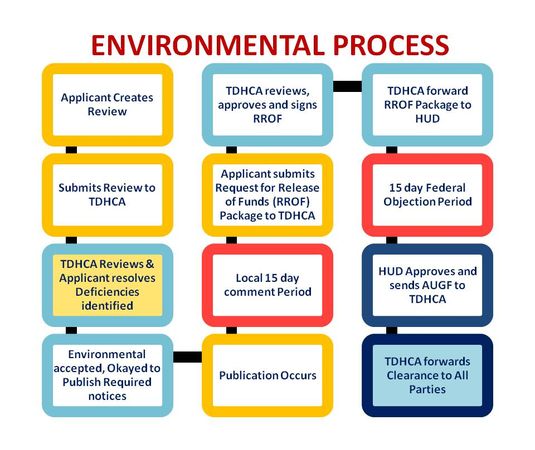If you or someone you know is in need of assistance, please visit our Help for Texans Page.
The single family environmental review process generally assumes that single family owner occupied homes or new construction infill housing is the scope of the project. (New development of a single family subdivision should follow the multifamily process.)
Limitations on Activities Prior to Environmental Clearance
Awardees cannot engage in any choice-limiting activities prior to environmental clearance per 24 CFR §58.22. Choice-limiting activities include but are not limited to these examples:
- Acquisition of land;
- Closing on loans including loans for interim financing;
- Signing a contract;
- Commencing construction
HUD requires a signed Certification as part of all contracts and environmental documents. This certification affirms an awareness of and intention not to take any "choice-limiting" actions until environmental clearance is obtained. The consequences of moving forward on a project without environmental clearance will result in both in a loss of time and loss of funding.
This certification extends to the use of other funds utilized for the same project regardless of funding source, including private sources.
Sub-recipients that prematurely engage in a choice-limiting activity will NOT be reimbursed for that activity, and the entire project becomes ineligible for reimbursement from the funding program.
Environmental Review Process

Legend
Gold = applicant/awardee
Blue = TDHCA
Dark Blue = HUD
Red = Comment Periods
Determine Level of Review:
(See Sample Project Types for Single Family Activities)
EXEMPT
Administration & Management, Environmental review, Inspection & Testing, Purchase of Insurance, Engineering/Design
CATEGORICALLY EXCLUDED NOT SUBJECT TO 58.5
Tenant Based Rental Assistance, Supportive Services, Operating Costs, Homebuyer Assistance (down payment assistance)
CATEGORICALLY EXCLUDED SUBJECT TO 58.5
Acquisition, Rehabilitation, Demolition, New Construction (as long as no more than 4 units are within 2,000 feet of a 5th unit)
ENVIRONMENTAL ASSESSMENT
New Construction (where at least 5 units are within 2,000 feet of each other), a change in use
Mandatory Submission Format
Required Format for Submitting Environmental Review Documents for Single Family Projects (effective May 2016)
All HUD Part 58 Environmental Review Submissions must follow the format suggested by HUD found on the HUD Exchange website under the right toolbar titled “Suggested Formats and Sample Notices,” see https://www.hudexchange.info/programs/environmental-review/. The reviewer chooses the appropriate forms based on the level of review. HUD’s current format now incorporates the project description and determination of level of review forms; a separate document is no longer needed for these items. The Environmental Submission should follow the document order as listed below:
- Location Map, close up with overview of area to be reviewed and a broader map view to show location in the State;
- Tiering Plan (if appropriate);
- HUD Form (which now incorporates the project description, level of review and all required checklists into one document);
- All Supporting Documentation in the order of the HUD checklist with attachment letters or numbers for identifiers for each support section;
- Supporting documents should include all data utilized for the review including maps submitted with correspondence to State or Federal Agencies
- All submissions must be in electronic form
Effective May 6, 2016, all environmental review submissions MUST adhere to this format or the Department will reject the submission. This requirement should enable the Department to provide quicker and more streamlined reviews.
Environmental Submission on the TDHCA Contract System is Now Mandatory
All environmental submissions must be done on the TDHCA Housing Contract System with the exception of CDBG/OCI, see the guidance below for step by step explanations.
- Training Manual (PDF)
- Webinar training video (46:51) (Windows Media Player required.)
- Frequently Asked Questions and Set-up Creation Scenarios (DOC)
HUD Environmental Forms and guidance can be found at:
https://www.hudexchange.info/programs/environmental-review/
Tiering an Environmental Review
Tiering eliminates repetitive discussions of the same environmental issues at subsequent levels of review. Tiering is appropriate when there is a requirement to evaluate a policy or proposal in the early stages of development or when site-specific analysis or mitigation is not currently feasible and a narrower or more focused analysis is better done at a later date. The site specific review need only reference or summarize the issues addressed in the previously completed broad review.
Tier 1 – Broad Review
The Broad Review identifies and evaluates those issues ready and suitable for decision and excludes those issues not relevant to the policy, program or project.
- The broad review should also establish the policy, standard or process to be followed in the site specific review (if mitigation is required).
- These standards or policies are outlined in the tiering plan. See below for requirements for a tiering plan and a sample tiering plan.
- When publishing the required notices, a summary of the assessment and the elements to be considered in the site specific review should be included in the project description on both the publication and the request for release of funds.
Tier 2 – Site Specific Review
The Site Specific Checklist is a “created” document for the tiered review and reflects the issues identified for a focused review.
The Site Specific Checklist should refer to the elements already reviewed, include the signature date of the authority to use grant funds, list all elements to be reviewed, and contain a signature from the preparer.

